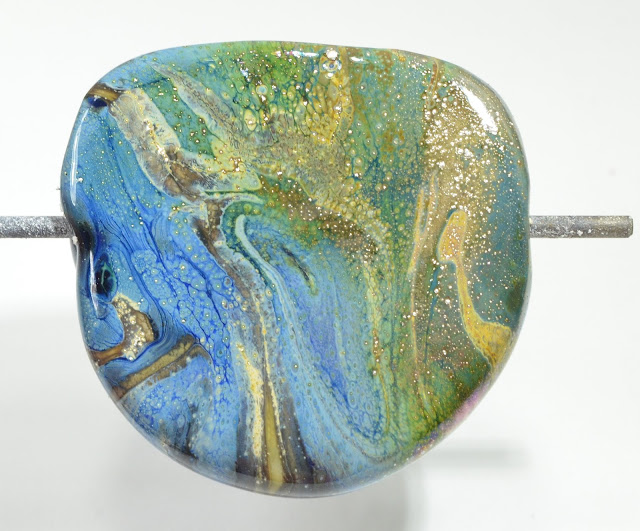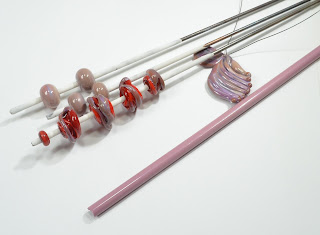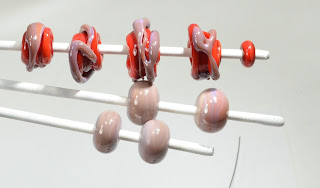Just some eye-candy. I like this one.
Wednesday, January 31, 2018
Monday, January 29, 2018
You are not going to believe what this colour is ...
 Seriously - you are just not going to believe it.
Seriously - you are just not going to believe it.
I got my hands on the latest colour from Double Helix ...
Oracle-Black.
Black.

Let me just let that sink in for a bit.
Double Helix has a fine write-up for Oracle-Black, and the thing that grabbed my attention was "... reactive with lusters."
Oh ho, says I - that's gotta be the old silver-foil-turns-the-black-blue thing. I love that thing.
So I get out the silver foil, make a honking big bead in scraps of whatever, encase it in the Oracle-Black, (to make it go further), and then lay down the silver foil, burnishing, and gently apply the flame to melt the silver. A few swipes of ivory, melt, mash, and a little bit of reduction applied to the right hand side. That would be this bead.

Black.
Black that reliably and intensely reacts with silver to create a rich palette of blues. Greens when reduced.
This is a random selection of frits and powders - some Psyche for sure, also probably some Nyx and Kronos2 powders, maybe also some Terra powder, and a little GOK. (When I get low on a frit, I tend to dump them all into one tray.)

What else can I tell you? It is buttery smooth to work, much less stiff than the blacks usual blacks. Really delightful, actually.
 Double Helix says that it "will strike, does not spread excessively, and can be worked very hot without boiling."
Double Helix says that it "will strike, does not spread excessively, and can be worked very hot without boiling."Here you see a flattened, unannealed rod tip - and you can see that it shows blue. (This is strongly lit in order to show it).
Of the three "bits" below, the pointed leaf, on the left, went into the kiln still blue - I wanted to see if it would kiln-strike, and it did.
The rounded leaf (on the back of the pile) - I deliberately struck, and it went into the kiln black. The wavey bit just looked black the whole time.

 Only if you hold it up to very intense light can you see some blue still.
Only if you hold it up to very intense light can you see some blue still.For this bead, I make an ivory bead, put very thin trails of Oracle-Black on it, and then cooked the snot out of it. As you can see - this did not strike in the kiln, but I really did put it on very thin. I rather like the effect. It hasn't really webbed up, like the old intense black used to do, but there is a little something going on. But, like I said, I really tortured it here. And I like it.

The mane and eye are Oracle-Black, and you can see it functions very nicely as a normal black. ;-)

The buttery smooth working characteristic and the silver reactions alone make this one a keeper in my books. And Double-Helix's policy of making glasses with a mandate of low-toxicity is certainly something to think about.
I'm going to have a lot of fun with this one.
Wednesday, January 24, 2018
Effetre 712 Whisper
 I blogged this a while ago, (2009), and apparently forgot it completely.
I blogged this a while ago, (2009), and apparently forgot it completely.I can't say I really have changed my mind on it.
It's a ridiculously pale tint of pink, that requires being worked ridiculously cool.
I'm sure someone out there can make it look good, but lawdy, it ain't me.
This is what happens if you over heat it, and there was no amount of oxygen that would stop this scorching/blackening effect. The only thing that stopped it was moving to a smaller torch with a smaller flame.
Maybe you can market it as "Storm Cloud Sunset."
I'm sure I'm missing something, but this one is not a winner in my books.
Please don't confuse this with the CiM Whisper - which is a pale opal pink. Which apparently I scorched too. So maybe it's just me.
Tuesday, January 23, 2018
Comparison - Looking for EDP
As some of you know, Effetre has ceased production of 254 - Purple (Orchid) - commonly referred to as EDP (Evil Devitrifying Purple).
This glorious colour can produce some interesting reactions, and it's tendency to devitrify (lose it's glossy, glassy look and become matte and a little chalky-looking) have made it a love or hate kind of glass.
But with it now being out of production - as changing legislation regarding environmental controls would require a reworking of the production process - for those who do love this colour - well - what's a body to do?
So recently - I had a bit of a search around the 254 numbers in the Effetre colour palette to see if I could find something similar.
My candidates were:
Effetre 256 - Dark Rose
Effetre 706 - Pinky Winky
Effetre 257 - Sedona
Effetre 253 - Striped Pink.
First up - the base line
EDP over Eff 428 Light Red. A particularly dark batch of EDP, and brutally shocky. Stick it in the kiln to pre-warm it - shocky. But great colour.
1. Eff 256 Dark Rose.
Such a pretty pink - and so nice to work. No shocking, no de-vit, a little streaky, and clearly too light a pink. Super pretty though.
2. Eff 706 Pinky Winky
Again, super nice to work - no shocking, no de-vit, a light pink, with a smidgeon of a blue ripple streak in it. Very pretty.
Here we have the head to head comparison - top mandrel is EDP, bottom is Striped Pink.
And the full set together. From the top - single mandrel with 2 beads - EDP.
Next pair of mandrels - Striped Pink. Then Sedona, and then Pinky Winky and finally, Dark Rose. The Pinky Winky and Dark Rose are very similar to each other, with the blue-ish bits distinguishing the Pinky Winky.
So there you have it. And if someone could make a glass to match the nail polish in the pictures above, that would be nice. Please and thank you. ;-)
This glorious colour can produce some interesting reactions, and it's tendency to devitrify (lose it's glossy, glassy look and become matte and a little chalky-looking) have made it a love or hate kind of glass.
But with it now being out of production - as changing legislation regarding environmental controls would require a reworking of the production process - for those who do love this colour - well - what's a body to do?
So recently - I had a bit of a search around the 254 numbers in the Effetre colour palette to see if I could find something similar.
My candidates were:
Effetre 256 - Dark Rose
Effetre 706 - Pinky Winky
Effetre 257 - Sedona
Effetre 253 - Striped Pink.
First up - the base line
EDP over Eff 428 Light Red. A particularly dark batch of EDP, and brutally shocky. Stick it in the kiln to pre-warm it - shocky. But great colour.
1. Eff 256 Dark Rose.
Such a pretty pink - and so nice to work. No shocking, no de-vit, a little streaky, and clearly too light a pink. Super pretty though.
2. Eff 706 Pinky Winky
Again, super nice to work - no shocking, no de-vit, a light pink, with a smidgeon of a blue ripple streak in it. Very pretty.
3. Eff 257 Sedona.
My money would have been on this one, but it was not a smart bet. Again - no shocking, no de-vit'ing, and it certainly looked darker going into the the kiln.
However, coming out of the kiln, it has developed a slightly brownish overtone, that is not working for me in the context of what I am trying to achieve. Not to say I don't like it - in the wave form on a wire, I like the variation a lot, and I think it really does evoke a southwestern sunset, but not what I was going for.
BTW - this was worked in the exact same flame as the others.
4. Eff 253 Striped Pink
Ding - ding - ding - ding! We have a winner! To my surprise - the closest match is Striped Pink - which is a cored rod (the center is something else - possibly for economic reasons). (Kind of like a reverse filigrana.)
I had no problem with it shocking, it does de-vit a little, like EDP, and if you have any of it lurking in your stash, it will be easy to ID as the transparent core gives the rods a very distinctive look when viewed end on.
I believe this is actually EDP layered over something else - a light transparent, so that makes it on point for what I want.
Here we have the head to head comparison - top mandrel is EDP, bottom is Striped Pink.
And the full set together. From the top - single mandrel with 2 beads - EDP.
Next pair of mandrels - Striped Pink. Then Sedona, and then Pinky Winky and finally, Dark Rose. The Pinky Winky and Dark Rose are very similar to each other, with the blue-ish bits distinguishing the Pinky Winky.
Sunday, January 21, 2018
Comparison: Opal Yellow, Stone Ground, Painted Hills
Effetre 266 Opal Yellow, CiM 351 Stone Ground, and CiM 313 Painted Hills.
Opal Yellow has long been known more for its reactions that as a colour to be used in its own right - somewhat unfairly, I feel.
Stone Ground is CiM's variation, and also is used for the way it interacts with other glass colours. However, you may have noticed that Stone Ground is a bit thin on the ground right now at the distributors, and you might be wondering what is your best bet as an alternate, and how they stack up.
 In which case, you might want to have a look at CiM Painted Hills. On the face of it, Painted Hills appears to be much too light to function as an equivalent, but it may actually be closer to Opal Yellow than you think.
In which case, you might want to have a look at CiM Painted Hills. On the face of it, Painted Hills appears to be much too light to function as an equivalent, but it may actually be closer to Opal Yellow than you think.
The unworked rods, from the top, Opal Yellow, Stone Ground and Painted Hills.

And from the ends - in the same order.

And here is the bead, still hot, before mashing. From the left, Opal Yellow, Stone Ground, Painted Hills. The dots are Double Helix Aurae
And after mashing, still hot.
And once out of the kiln. Again, from the left, Opal Yellow, Stone Ground, and Painted Hills. The Stone Ground base between the dots is a much richer, warmer colour, and the two ends are paler, although the Aurae dots are a better match between the Opal Yellow and the Stone Ground.
The reduced dots are so shiny - you can see at the edge of the bead it almost looks encased - that's actually just the shine on the dots.
It really depends on what you want it to do.
Opal Yellow has long been known more for its reactions that as a colour to be used in its own right - somewhat unfairly, I feel.
Stone Ground is CiM's variation, and also is used for the way it interacts with other glass colours. However, you may have noticed that Stone Ground is a bit thin on the ground right now at the distributors, and you might be wondering what is your best bet as an alternate, and how they stack up.
 In which case, you might want to have a look at CiM Painted Hills. On the face of it, Painted Hills appears to be much too light to function as an equivalent, but it may actually be closer to Opal Yellow than you think.
In which case, you might want to have a look at CiM Painted Hills. On the face of it, Painted Hills appears to be much too light to function as an equivalent, but it may actually be closer to Opal Yellow than you think.The unworked rods, from the top, Opal Yellow, Stone Ground and Painted Hills.

And from the ends - in the same order.

And here is the bead, still hot, before mashing. From the left, Opal Yellow, Stone Ground, Painted Hills. The dots are Double Helix Aurae
And after mashing, still hot.
And once out of the kiln. Again, from the left, Opal Yellow, Stone Ground, and Painted Hills. The Stone Ground base between the dots is a much richer, warmer colour, and the two ends are paler, although the Aurae dots are a better match between the Opal Yellow and the Stone Ground.
The reduced dots are so shiny - you can see at the edge of the bead it almost looks encased - that's actually just the shine on the dots.
It really depends on what you want it to do.
Subscribe to:
Posts (Atom)



































